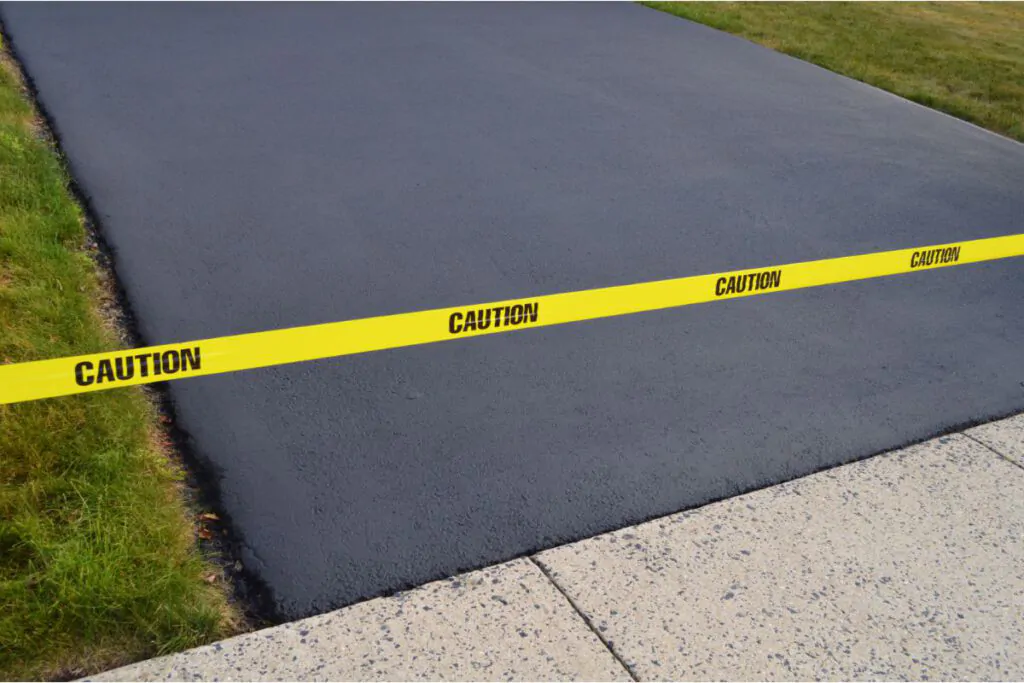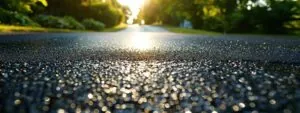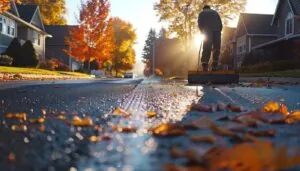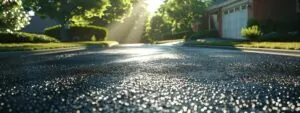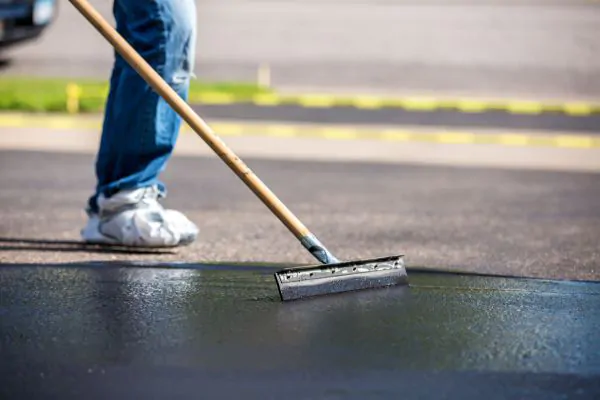
Driveway sealing is like giving your driveway a nice protective coat of armor. It helps keep your driveway looking fresh and prevents any cracks or damage from sneaking up on you. The process starts with cleaning the driveway to get rid of any dirt or debris. Then, a special sealant is applied evenly across the surface to create a solid barrier against the elements.
During the drying process, you might notice a shiny finish on your driveway, which is normal. This finish not only looks good but also means that your driveway is now well-protected.
And if you’ve recently had your driveway sealed, you might be itching to start using it right away. But hold your horses! It’s important to allow proper curing time before driving or walking on it.
First off, giving the seal coat enough time to cure ensures that it forms a strong and durable barrier against all sorts of nasties like oil, gas, and UV rays. If you start using your sealcoating driveway too soon, you risk damaging the newly applied seal coat, which means you’ll have to shell out more money for repairs down the line.
Also, rain, lack of heat, and humidity can effect with the curing process, so it’s best to wait for clear skies and dry weather before getting back to regular use. So, be patient, let that seal coat do its thing, and you’ll have a driveway that’s good-looking and long-lasting.
Why it’s important to wait before walking on a newly sealed driveway
We mentioned that it’s not a good idea to start using your newly sealed driveway right away. In this section, we’ll dive deeper into the exact reasons why.
A. Prevent damage to the sealant
Waiting before walking on a newly sealed driveway is important to avoid ruining all that fresh sealant. If you stroll on it too soon, you risk messing up that seal and ending up with a patchy, damaged driveway.
When the sealant is still curing, it needs time to bond and harden properly. If you stomp all over it too soon, you could leave footprints or impressions that can ruin the finish.
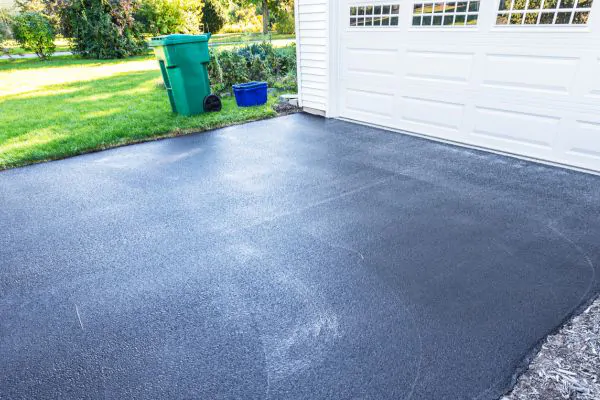
Walking on a newly sealed driveway can also cause the sealant to wear off quickly in high-traffic areas. The pressure and friction from footsteps can weaken the seal and make it more susceptible to damage from a vehicle driving over it or harsh weather conditions.
B. Avoid tracking sealant into the house
If you wait for the right amount of time before walking onto a newly coated driveway, you’ll avoid tracking sealant into your house.
But if that can’t be avoided, remember to wipe your shoes or boots thoroughly before stepping indoors. A simple wipe on the doormat can work wonders in preventing any sticky residue from coming inside. If you’re in a hurry and can’t clean your shoes right away, consider changing into a different pair before entering the house.
C. Ensures the longevity of the driveway sealant
When you give your driveway some time to fully set and cure after sealing, you’re helping to ensure the longevity of the sealant. Walking or driving on it too soon can cause the sealant to not dry properly, leading to cracks, peeling, or premature wear and tear.
How long should you wait before walking on a newly sealed driveway?
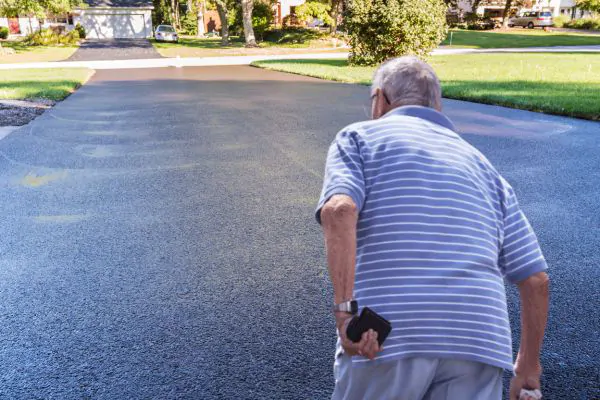
Typically, you should wait at least 24-48 hours before walking on a newly sealed driveway. This waiting period allows the sealant to dry completely and harden, ensuring a durable and long-lasting finish. That said, there are some important things to keep in mind.
A. Factors that affect drying time
There are a few key factors that can affect how long it takes for the sealant to dry and cure properly.
First off, the weather plays a big role. If it’s a hot and sunny day, the sealant will dry much faster compared to a cool or rainy day. High humidity can also slow down the drying process, so keep an eye on the weather forecast before you start.
Another factor to consider is the type of sealant you’re using. Different products have different drying times, so make sure to read the manufacturer’s instructions carefully. Applying the sealant too thickly can also prolong the drying time, so aim for a consistent and even coat.
Lastly, the condition of your driveway can impact drying time. If there is a pothole or two that hasn’t been properly filled and repaired before sealing, the sealant may take longer to dry in those areas. It’s important to prep your driveway thoroughly before applying the sealant to ensure a smooth and efficient drying process.
B. Recommended curing times for different types of sealants
When it comes to sealants, curing time can vary depending on the type you’re using. But don’t worry, we’ve got your back with some recommended times to help you out.
For silicone sealants, you’ll typically want to give it about 24 hours to fully cure. This means letting it sit without disturbing it so it can set properly and do its job effectively.
On the other hand, acrylic sealants are usually quicker to cure, taking anywhere from 12 to 18 hours. Just make sure to check the specific instructions on the product you’re using to be safe.
Coal tar-based and concrete sealants cure in about 24 to 48 hours, and they offer excellent protection against water, chemicals, and UV radiation.
C. Common misconceptions about drying time
So, you’ve just sealed your driveway by and now you’re probably wondering when it’ll be ready for action. One common misconception is that drying time is the same as curing time. While the surface may appear dry to the touch after a certain time, it doesn’t necessarily mean that the sealant has fully cured.
Another misconception is that drying time is solely based on the type of sealer used. Proper weather conditions play a crucial role in the drying process. As previously mentioned, factors like humidity, temperature, and sunlight exposure can impact how quickly the sealer cures.
Sunlight speeds up drying time – that must be a good thing, right? Well, not necessarily. While sunlight can help evaporate moisture and speed up the drying process, excessive heat and direct sunlight can also cause the sealant to dry too quickly, leading to improper curing and potential surface defects.
You may be interested in: When is the Best Time to Seal Your Driveway?
IV. Signs that your driveway is ready to be walked on
A. Visual inspection of the surface
So, you finally got your driveway sealed and now you’re wondering when you can step on it, huh? Well, one way to figure that out is by giving it a visual inspection. Look at the surface – is it smooth and even with no visible wet spots or tackiness? If it looks dry and has a nice uniform sheen, chances are it’s ready for some foot traffic.
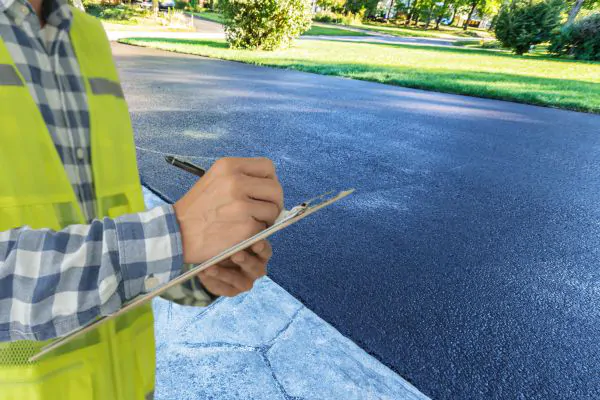
Another thing to keep in mind is the weather. If you just had your driveway sealed and it’s been a hot and sunny day, it might be good to wait a bit longer for it to fully cure. If it’s been cooler or more humid, it might take a bit longer for the sealer to dry.
B. Testing the surface for tackiness
Take a walk over to your freshly sealed driveway and lightly press your finger onto the surface. If your finger comes away clean with no sticky residue, then you’re good to go! Another trick is to gently place your foot on the driveway and give it a little twist. If your foot slides easily without leaving marks, then you’re all set to start using your driveway again.
Remember, patience is key when it comes to newly sealed surfaces, so give it some time to fully cure before going all in with heavy traffic.
C. Checking for proper weather conditions
Ideally, you should let the sealant cure for at least 24 hours before walking on it. This gives it enough time to dry and harden properly. But you must make sure the weather is on your side – it’s best to seal your driveway on a warm, sunny day with no rain in the forecast. Rain can mess with the sealant’s drying process, so it’s best to wait for clear skies.
V. Tips for maintaining your newly sealed driveway
A. Avoid parking heavy vehicles on the driveway

One thing you want to avoid is parking heavy vehicles on your driveway. We’re talking about big trucks, loaded delivery vans, or even that friend who drives an SUV the size of a tank. These heavy vehicles can put a lot of pressure on the fresh sealant and cause it to crack, chip, or wear down faster than you’d like.
Consider setting up some clear boundaries with your family or housemates to make sure everyone knows to park heavy vehicles elsewhere.
B. Regularly clean and sweep the surface
It may not seem like a big deal, but taking the time to clean up those leaves, dirt, and debris can make a huge difference in how long your driveway lasts.
When you leave dirt and leaves sitting on your driveway, they can cause some serious damage over time. They can create cracks and chips in the surface, leading to costly repairs down the road. By simply sweeping or hosing off your driveway regularly, you can prevent this buildup and extend the life of your driveway.
Plus, keeping your driveway clean not only helps it last longer, but also enhances the overall appearance of your home. A clean driveway can boost your curb appeal and make your property look well-maintained and inviting.
C. Schedule routine maintenance checks
Taking a few minutes here and there to inspect your driveway can make a big difference in how long it lasts.
First things first, give your driveway a once-over every couple of months to look for any cracks, potholes, or signs of wear and tear. If you spot any issues, tackle them right away before they become bigger problems. You can fill in minor cracks with asphalt crack filler or patch up small potholes to prevent them from growing.
VI. Conclusion
When it comes to sealing your driveway, it’s super important to read and stick to the manufacturer’s instructions. Following the guidelines will ensure that you apply the sealant correctly and get the best results possible. From the right application techniques to the recommended drying times, the manufacturer knows best how to make your driveway look fresh and last longer.
Sealing your driveway helps to protect it from the elements. This means it can withstand rainy days, hot sun, and even harsh winter weather without cracking or deteriorating. Another great perk is that a sealed driveway looks fresh and clean. It gives your home a polished appearance and boosts curb appeal. Plus, it’s easier to clean and maintain, saving you time and effort in the long run.

